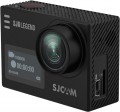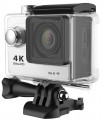Thread 1/4" (for tripod)
The presence of a
1/4" threaded socket on the camera body. It is this size that is standard for modern
tripods and is used in most of these devices. So this feature allows you to mount the camera on a tripod without using adapters and other additional equipment.
Quad HD
The ability of the camera to shoot QuadHD video.
This standard includes an extensive set of resolutions — from 1440 to 3456 pixels horizontally and from 1440 to 2160 pixels vertically, with almost two dozen intermediate options. It is a rather specific transitional option between the relatively inexpensive FullHD 1080p and the demanding UltraHD 4K, allowing you to shoot higher resolution video than 1080p without significantly increasing the cost of equipment. Note that pure QuadHD resolutions are rare in TVs and monitors, but modern technologies make it possible to comfortably watch videos of this format on any high-resolution screen.
Another important parameter given in this paragraph is the frame rate. The higher it is, the smoother the movement in the frame will be, and the details in dynamic scenes will be visible clearly. For example, a filming speed of
25 fps or
30 fps approximates the standard frame rate in film and television; such an image is quite viewable, but fast-moving objects in the frame will look blurry. With an increase in speed to
60 fps, this effect becomes almost imperceptible. The highest QuadHD frame rate found in modern action cameras is
120 fps; this frequency is used when shooting slow-motion video (as well as models with a frequency of
100 fps) because at a n
...ormal playback speed, 60 fps is enough.Ultra HD (4K)
The ability of the camera to shoot Ultra HD 4K video.
This format covers several resolutions in which the horizontal frame size is approximately 4K pixels. The most popular in action cameras is 3840x2160 (twice the FullHD frame on each side), but there are other options — for example, 3840x1920, corresponding to an aspect ratio of 2:1. In general, 4K is a kind of successor to Full HD: among HD standards that surpass Full HD, UltraHD is the most popular, in particular, many advanced TVs are produced with 3840x2160 screens. On the other hand, this format is quite demanding in terms of processing power and memory, so it is relatively rare in action cameras, mainly among premium models.
Another important parameter given in this paragraph is the frame rate. The higher it is, the smoother the movement in the frame will be, and the details in dynamic scenes will be visible clearly. However, in UltraHD mode, most modern action cameras produce a very low frame rate — most often
30 fps, and in some models
24 fps or even
15 fps. This video is quite viewable, but fast movement in the frame may look blurry. There are cameras capable of shooting UltraHD at a solid speed of
60 fps — the blurring effect during such shooting is almost imperceptible. However, such a model cost is high.
Field of view
For models with several lenses, as a rule, this parameter is indicated for each lens.
Most often (unless otherwise indicated), the specifications indicate the field of view by the diagonal of the frame; in some
ultra-wide-angle lenses it can exceed 180°. A special case is made up of lenses for which a 360° view is declared: this means that the optics cover the entire hemisphere in front of it. Such lenses are found in panoramic and 360-degree cameras (see “Product type”).
In general, the field of view primarily determines what area of the scene is being captured into the frame. Accordingly, the wider it is, the more space the camera captures, and the lower the likelihood that something that is happening will be off-screen. On the other hand, it is worth considering that a strong increase in the field of view leads to distortions of the “picture”, especially at the edges, as well as, to a decrease in the size of visible objects and a decrease in detail. Detailed recommendations regarding choosing a camera based on this parameter can be found in special sources.
Digital stabilization
The presence of a digital (electronic) stabilization system in the camera design.
Any stabilization is intended to compensate for small juddering of the image that occurs due to the instability of the hold in the hands, vibrations from the motor or road roughness (when used in transport), etc.
Digital stabilization is carried out as follows: a reserve area is allocated along the edges of the sensor, which under normal conditions does not participate in the formation of the final image. If the device is being shaken, the camera electronics select certain parts of the image from the reserve and build the image in such a way that in the end, it remains stable.
Compared to other methods of stabilization, digital systems are extremely simple and reliable. Moreover, they are inexpensive and have almost no effect on the weight, dimensions, and price of the camera. At the same time, with this method of stabilization, the effective area of the image sensor is reduced, which can adversely affect the image quality and the amount of noise on it.
Megapixels
The number of megapixels in the action camera sensor, in other words, the resolution of this sensor(1 megapixel is 1 million photosensitive points).
There is an opinion that the higher the resolution, the better the image quality. It is true from the point of view that manufacturers are trying to install high-resolution sensors in advanced cameras. At the same time, there are no strict dependencies here, and from the technical point of view, the number of megapixels determines only the maximum image resolution that can be captured using this sensor. The quality of this picture will depend both on several features of the sensor itself (size, type, special design solutions), and the specs of the camera. So when choosing, you should focus not so much on the resolution of the image sensor, but on the general class of the camera and reviews with examples of footage.
Photo resolution
The maximum resolution at which the action camera can take photos. Specified in pixels horizontally and vertically.
This parameter is directly related to the resolution of the image sensor(see above): the total number of pixels in the photo, usually, corresponds to the number of pixels in the sensor. For example, a photo resolution of 4608x3456 corresponds to a sensor of 15925248 pixels, or approximately 16 megapixels. If the number of pixels in the photo is greater than the claimed resolution of the sensor, then the manufacturer uses software tricks that allow you to improve the photo resolution to a higher one than originally. This reduces the cost of devices but also affects the quality of images.
Theoretically, high-resolution images can provide good detail, but in fact, much depends on the specs of the sensor (primarily physical size) and image processing features.
Display
— Diagonal. The larger the screen, the more convenient it is to watch (and also to control if the display is touch-sensitive). On the other hand, the diagonal of the
built-in display directly affects the size of the case, and action cameras should be quite compact. Thus, there are practically no screens larger than 2.5" in modern action cameras.
— Resolution. Theoretically, the higher the resolution, the clearer and better image the screen produces. On the other hand, displays in action cameras are designed mainly for menu operation and footage preview — and for these purposes, especially high resolutions are not needed. For models with two screens, the rear display is considered the main display.
— Touch screen. Display equipped with a sensor and responsive to touch like in smartphones/tablets. Control through such a display is simpler and more intuitive than using buttons, rotary knobs, etc. On the other hand, for more or less convenient control, the
touch screen must be quite large, which affects the dimensions of the entire camera.
Front screen
The presence in the camera of a screen mounted on the front panel, next to the lens. Other displays may not be present at all; in such cases, the diagonal, resolution and other parameters are given for
the front screen.
It is worth noting that most often the simplest black-and-white displays are installed on the front panel, suitable only for text and basic graphic information. However, even on such a screen, you can display a wide variety of service data: the current mode of operation (photo, video, standby), the resolution used, the shooting time, the amount of free space on the drive, etc. But more advanced displays are not used as front displays: a full-colour screen is needed only for taking a selfie, and for this you can use a
remote display with a remote control(see "Control") or a smartphone connected to the camera.

